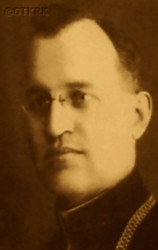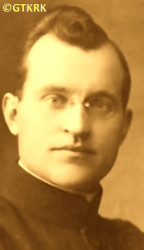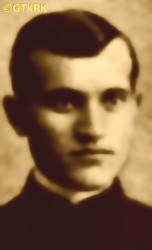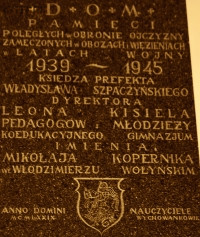Roman Catholic
St Sigismund parish
05-507 Słomczyn
85 Wiślana Str.
Konstancin deanery
Warsaw archdiocese, Poland
full list:
displayClick to display full list

searchClick to search full list by categories
wyświetlKliknij by wyświetlić pełną listę po polsku

szukajKliknij by przeszukać listę wg kategorii po polsku

Martyrology of the clergy — Poland
XX century (1914 – 1989)
personal data
surname
SZPACZYŃSKI
surname
versions/aliases
SPACZYŃSKI
forename(s)
Vladislav (pl. Władysław)
function
diocesan priest
creed
Latin (Roman Catholic) Church RCmore on
en.wikipedia.org
[access: 2014.09.21]
diocese / province
Lutsk diocesemore on
en.wikipedia.org
[access: 2013.05.19]
Lutsk‐Zhytomyr diocese (aeque principaliter)more on
www.catholic-hierarchy.org
[access: 2021.12.19]
RC Military Ordinariate of Polandmore on
en.wikipedia.org
[access: 2014.12.20]
academic distinctions
Bachelor of Canon Law
honorary titles
honorary canonmore on
honorary canon
(c. 1930, St Peter and St Paul the Apostles RC cathedral church, Lutsktoday: Lutsk city rai., Volyn obl., Ukraine
more on
en.wikipedia.org
[access: 2021.09.17])
date and place
of death
23.06.1941

Lutsktoday: Lutsk city rai., Volyn obl., Ukraine
more on
en.wikipedia.org
[access: 2021.09.17]
alt. dates and places
of death
1941, 01‑02.11.1940
details of death
In 1920, during the Polish–Russian War of 1919‐1921, prob. was in Lublin, studying at the University of Lublin (later the Catholic University of Lublin KUL), which had just been founded by the professors of the Theological Academy in Saint Petersburg, which had been dissolved by the Russian Bolsheviks. Became then — perhaps when the great Russian offensive of 1920 was approaching the heart of Poland — a chaplain of the Polish Army. The Russians failed to capture Lublin — the Rus. Первая Конная армия (Eng. 1st Horse Army), under the command of General Semyon Budyonny, attacking from the south‐east was stopped before Lublin, and the Polish triumph in the Battle of Warsaw on c. 15.08.1920 (known as the „Miracle on the Vistula”) led to the Russian escape to the east.
Released from the Polish Army and transferred to the reserves in 1921. In 1923, 1924, 1925, 1927 and 1929 appointed again the reserve chaplain of the Polish Army (from 25.11.1926 each time for a statutory period of 2 years).
After German and Russian invasion of Poland in 09.1939 and start of the World War II, in first years of Russian occupation, took active part in clandestine Polish resistance Armed Struggle Union ZWZ organization (part of the emerging Polish Clandestine State).
Arrested by the Russians on 15.06.1940 (or 28/29.06.1940) in Kovel, together with Fr Marian Tokarzewski.
Held in Kovel and Lutsk prisons.
On 01‐02.11.1940 in Lutsk sentenced to death in a group trial of 35 Poles and held in a death cell in Lutsk prison. Defended himself without „the help” of a defender sent by the Russians from Moscow.
Murdered in Lutsk prison by the genocidal Russian NKVD organization during the massacre of c. 2,000 prisoners, just before the arrival of German troops after German attack on 22.06.1941 of their erstwhile ally Russians — together with Fr Joseph Czurko, Fr Bronislav Galicki and Fr Francis Rutkowski.
alt. details of death
According to other sources murdered at a transport to a concentration camp (after commuting of the death sentence to slave labour at Gulag camps), n. Arkhangels.
According to yet another murdered on the day of death sentence in Łuck.
cause of death
mass murder
perpetrators
Russians
sites and events
06.1941 massacres (NKVD)Click to display the description, LutskClick to display the description, GulagClick to display the description, Trial of 01‐02.11.1940Click to display the description, Ribbentrop‐MolotovClick to display the description, Pius XI's encyclicalsClick to display the description, Polish‐Russian war of 1919‐1921Click to display the description
date and place
of birth
13.03.1887

Chudnivtoday: Chudniv hrom., Zhytomyr rai., Zhytomyr obl., Ukraine
more on
en.wikipedia.org
[access: 2021.09.17]
parents
SZPACZYŃSKI Raymond
🞲 ?, ? — 🕆 ?, ?

OGIŃSKA Francesca
🞲 ?, ? — 🕆 ?, ?
presbyter (holy orders)
ordination
20.06.1910

Zhytomyrtoday: Zhytomyr urban hrom., Zhytomyr rai., Zhytomyr obl., Ukraine
more on
en.wikipedia.org
[access: 2021.09.17]
positions held
08.1934 – 1940
prefect — Koveltoday: Kovel urban hrom., Kovel rai., Volyn obl., Ukraine
more on
en.wikipedia.org
[access: 2021.12.19] ⋄ primary schools ⋄ St Anne RC parish ⋄ Koveltoday: Kovel urban hrom., Kovel rai., Volyn obl., Ukraine
more on
en.wikipedia.org
[access: 2021.12.19] RC deanery
1937 – 1940
confessor (ordinary) — Koveltoday: Kovel urban hrom., Kovel rai., Volyn obl., Ukraine
more on
en.wikipedia.org
[access: 2021.12.19] ⋄ monastery, Benedictine Nuns OSB
c. 1934
lecturer — Lutsktoday: Lutsk city rai., Volyn obl., Ukraine
more on
en.wikipedia.org
[access: 2021.09.17] ⋄ canon law, Theological Seminary
c. 1931 – c. 1933
moderator — Volodymyr‐Volynskyitoday: Volodymyr, Volodymyr urban hrom., Volodymyr rai., Volyn obl., Ukraine
more on
en.wikipedia.org
[access: 2020.07.31] ⋄ Minor Theological Seminary (Seminarium Minus) — canon (Lat. canonicus)
1923 – c. 1934
prefect — Volodymyr‐Volynskyitoday: Volodymyr, Volodymyr urban hrom., Volodymyr rai., Volyn obl., Ukraine
more on
en.wikipedia.org
[access: 2020.07.31] ⋄ St Joachim and St Anne RC parish (main parish) ⋄ Volodymyr‐Volynskyitoday: Volodymyr, Volodymyr urban hrom., Volodymyr rai., Volyn obl., Ukraine
more on
en.wikipedia.org
[access: 2020.07.31] RC deanery — secondary schools, incl. Nicolaus Copernicus's State Co–educational Gymnasium, Catholic School of Crafts and Industry; activist of the Polish School Association
1919 – 1922
student — Lublintoday: Lublin city pov., Lublin voiv., Poland
more on
en.wikipedia.org
[access: 2021.08.20] ⋄ Department of Canon Law and Moral Sciences, Catholic University of Lublin KUL [i.e. Catholic University of Lublin KUL (since 1928) / clandestine Catholic University of Lublin KUL (1939‐1944) / University of Lublin (1918‐1928)] — postgraduate specialised studies, on 24.03.1922 crowned with a bachelor's degree in canon law
1921
priest — Ostrohtoday: Ostroh urban hrom., Rivne rai., Rivne obl., Ukraine
more on
en.wikipedia.org
[access: 2021.09.17] ⋄ Assumption of the Blessed Virgin Mary RC parish ⋄ Ostrohtoday: Ostroh urban hrom., Rivne rai., Rivne obl., Ukraine
more on
en.wikipedia.org
[access: 2021.09.17] RC deanery
c. 1920
RC military chaplain — Polish Armed Forces — by L. 2845 decree of the Commander‐in‐Chief of 14.04.1921, at the request of the Bishop's Curia of the Polish Army, demobilised from the Polish Army
c. 1918
vicar — Moshnytoday: Moshny hrom., Cherkasy rai., Cherkasy obl., Ukraine
more on
uk.wikipedia.org
[access: 2023.03.02] ⋄ Nativity of the Blessed Virgin Mary RC parish ⋄ Zvenyhorodkatoday: Zvenyhorodka urban hrom., Zvenyhorodka rai., Cherkasy obl., Ukraine
more on
en.wikipedia.org
[access: 2021.12.19] RC deanery — also: chaplain at Cherkasy and Horodyshche chapels
c. 1913 – c. 1914
vicar — Dubnotoday: Dubno urban hrom., Dubno rai., Rivne obl., Ukraine
more on
en.wikipedia.org
[access: 2020.11.27] ⋄ St John of Nepomuk the Martyr RC parish ⋄ Dubnotoday: Dubno urban hrom., Dubno rai., Rivne obl., Ukraine
more on
en.wikipedia.org
[access: 2020.11.27] RC deanery
till 1910
student — Zhytomyrtoday: Zhytomyr urban hrom., Zhytomyr rai., Zhytomyr obl., Ukraine
more on
en.wikipedia.org
[access: 2021.09.17] ⋄ philosophy and theology, Theological Seminary
others related
in death
CZURKOClick to display biography Joseph Casimir, GALICKIClick to display biography Bronislav, RUTKOWSKIClick to display biography Francis, TOKARZEWSKIClick to display biography Marian
sites and events
descriptions
06.1941 massacres (NKVD): After German attack of Russian‐occupied Polish territory and following that of Russia itself, before a panic escape, Russians murdered — in accordance with the genocidal order issued on 24.06.1941 by the Russian interior minister Lawrence Beria to murder all prisoners (formally „sentenced” for „counter‐revolutionary activities”, „anti‐Russian acts”, sabotage and diversion, and political prisoners „in custody”), held in NKVD‐run prisons in Russian occupied Poland, Lithuania, Latvia and Estonia — c. 40,000‐50,000 prisoners. In addition Russians murdered many thousands of victims arrested after German attack regarding them as „enemies of people” — those victims were not even entered into prisons’ registers. Most of them were murdered in massacres in the prisons themselves, the others during so‐called „death marches” when the prisoners were driven out east. After Russians departure and start of German occupation a number of spontaneous pogroms of Jews took place. Many Jews collaborated with Russians and were regarded as co‐responsible for prison massacres. (more on: en.wikipedia.orgClick to attempt to display webpage
[access: 2021.12.19])
Lutsk: Prison run in 1939‐1941 by the Russians. After German attack in 06.1941 Russians murdered there approx. 2,000 prisoners. Again used by the Russians after 1944. (more on: pl.wikipedia.orgClick to attempt to display webpage
[access: 2017.03.11])
Gulag: The acronym Gulag comes from the Rus. Главное управление исправительно‐трудовых лагерей и колоний (Eng. Main Board of Correctional Labor Camps). The network of Russian concentration camps for slave labor was formally established by the decision of the highest Russian authorities on 27.06.1929. Control was taken over by the OGPU, the predecessor of the genocidal NKVD (from 1934) and the MGB (from 1946). Individual gulags (camps) were often established in remote, sparsely populated areas, where industrial or transport facilities important for the Russian state were built. They were modeled on the first „great construction of communism”, the White Sea‐Baltic Canal (1931‐1932), and Naftali Frenkel, of Jewish origin, is considered the creator of the system of using forced slave labor within the Gulag. He went down in history as the author of the principle „We have to squeeze everything out of the prisoner in the first three months — then nothing is there for us”. He was to be the creator, according to Alexander Solzhenitsyn, of the so‐called „Boiler system”, i.e. the dependence of food rations on working out a certain percentage of the norm. The term ZEK — prisoner — i.e. Rus. заключенный‐каналоармец (Eng. canal soldier) — was coined in the ITL BelBaltLag managed by him, and was adopted to mean a prisoner in Russian slave labor camps. Up to 12 mln prisoners were held in Gulag camps at one time, i.e. c. 5% of Russia's population. In his book „The Gulag Archipelago”, Solzhenitsyn estimated that c. 60 mln people were killed in the Gulag until 1956. Formally dissolved on 20.01.1960. (more on: en.wikipedia.orgClick to attempt to display webpage
[access: 2024.04.08])
Trial of 01‐02.11.1940: On 01—02.11.1940 (according to other sources on 31.10.1940 or 09.11.1940) 35 Poles were sentenced to death by Rosjan in group trial in Lutsk for „active and insidious anti‐Soviet activity, forming a [clandestine] organization and forging a conspiracy to forcibly detach of Volyn from [Russia]”. Among them were at least 6 Catholic priests. At least one of them prob. had a sentence commuted to slave labour in Russian concentration camps Gulag — perished during the transport to the camps. Prob. four were murdered by Russians during genocide massacre of c. 2,000 Lutsk prisoners after German attack of Russians in 06.1941. One survived under a pile of slaughtered lifeless bodies… (more on: katolicy1844.republika.plClick to attempt to display webpage
[access: 2021.12.19])
Ribbentrop‐Molotov: Genocidal Russian‐German alliance pact between Russian leader Joseph Stalin and German leader Adolf Hitler signed on 23.08.1939 in Moscow by respective foreign ministers, Mr. Vyacheslav Molotov for Russia and Joachim von Ribbentrop for Germany. The pact sanctioned and was the direct cause of joint Russian and German invasion of Poland and the outbreak of the World War II in 09.1939. In a political sense, the pact was an attempt to restore the status quo ante before 1914, with one exception, namely the „commercial” exchange of the so‐called „Kingdom of Poland”, which in 1914 was part of the Russian Empire, fore Eastern Galicia (today's western Ukraine), in 1914 belonging to the Austro‐Hungarian Empire. Galicia, including Lviv, was to be taken over by the Russians, the „Kingdom of Poland” — under the name of the General Governorate — Germany. The resultant „war was one of the greatest calamities and dramas of humanity in history, for two atheistic and anti‐Christian ideologies — national and international socialism — rejected God and His fifth Decalogue commandment: Thou shall not kill!” (Abp Stanislav Gądecki, 01.09.2019). The decisions taken — backed up by the betrayal of the formal allies of Poland, France and Germany, which on 12.09.1939, at a joint conference in Abbeville, decided not to provide aid to attacked Poland and not to take military action against Germany (a clear breach of treaty obligations with Poland) — were on 28.09.1939 slightly altered and made more precise when a treaty on „German‐Russian boundaries and friendship” was agreed by the same murderous signatories. One of its findings was establishment of spheres of influence in Central and Eastern Europe and in consequence IV partition of Poland. In one of its secret annexes agreed, that: „the Signatories will not tolerate on its respective territories any Polish propaganda that affects the territory of the other Side. On their respective territories they will suppress all such propaganda and inform each other of the measures taken to accomplish it”. The agreements resulted in a series of meeting between two genocidal organization representing both sides — German Gestapo and Russian NKVD when coordination of efforts to exterminate Polish intelligentsia and Polish leading classes (in Germany called «Intelligenzaktion», in Russia took the form of Katyń massacres) where discussed. Resulted in deaths of hundreds of thousands of Polish intelligentsia, including thousands of priests presented here, and tens of millions of ordinary people,. The results of this Russian‐German pact lasted till 1989 and are still in evidence even today. (more on: en.wikipedia.orgClick to attempt to display webpage
[access: 2015.09.30])
Pius XI's encyclicals: Facing the creation of two totalitarian systems in Europe, which seemed to compete with each other, though there were more similarities than contradictions between them, Pope Pius XI issued in 03.1937 (within 5 days) two encyclicals. In the „Mit brennender Sorge” (Eng. „With Burning Concern”) published on 14.03.1938, condemned the national socialism prevailing in Germany. The Pope wrote: „Whoever, following the old Germanic‐pre‐Christian beliefs, puts various impersonal fate in the place of a personal God, denies the wisdom of God and Providence […], whoever exalts earthly values: race or nation, or state, or state system, representatives of state power or other fundamental values of human society, […] and makes them the highest standard of all values, including religious ones, and idolizes them, this one […] is far from true faith in God and from a worldview corresponding to such faith”. On 19.03.1937, published „Divini Redemptoris” (Eng. „Divine Redeemer”), in which criticized Russian communism, dialectical materialism and the class struggle theory. The Pope wrote: „Communism deprives man of freedom, and therefore the spiritual basis of all life norms. It deprives the human person of all his dignity and any moral support with which he could resist the onslaught of blind passions […] This is the new gospel that Bolshevik and godless communism preaches as a message of salvation and redemption of humanity”… Pius XI demanded that the established human law be subjected to the natural law of God , recommended the implementation of the ideal of a Christian state and society, and called on Catholics to resist. Two years later, National Socialist Germany and Communist Russia came together and started World War II. (more on: www.vatican.vaClick to attempt to display webpage
[access: 2023.05.28], www.vatican.vaClick to attempt to display webpage
[access: 2023.05.28])
Polish‐Russian war of 1919‐1921: War for independence of Poland and its borders. Poland regained independence in 1918 but had to fight for its borders with former imperial powers, in particular Russia. Russia planned to incite Bolshevik‐like revolutions in the Western Europe and thus invaded Poland. Russian invaders were defeated in 08.1920 in a battle called Warsaw battle („Vistula river miracle”, one of the 10 most important battles in history, according to some historians). Thanks to this victory Poland recaptured part of the lands lost during partitions of Poland in XVIII century, and Europe was saved from the genocidal Communism. (more on: en.wikipedia.orgClick to attempt to display webpage
[access: 2014.12.20])
sources
personal:
www.grupy.banzaj.plClick to attempt to display webpage
[access: 2013.05.19], www.klub-generalagrota.plClick to attempt to display webpage
[access: 2012.11.23], biographies.library.nd.eduClick to attempt to display webpage
[access: 2014.11.14], www.duszki.plClick to attempt to display webpage
[access: 2012.11.23]
bibliographical:
„Register of Latin rite Lviv metropolis clergy’s losses in 1939‐45”, Józef Krętosz, Maria Pawłowiczowa, editors, Opole, 2005
„Biographical lexicon of Lviv Roman Catholic Metropoly clergy victims of the II World War 1939‐1945”, Mary Pawłowiczowa (ed.), Fr Joseph Krętosz (ed.), Holy Cross Publishing, Opole, 2007
„Lexicon of Polish clergy repressed in USSR in 1939‐1988”, Roman Dzwonkowski, SAC, ed. Science Society KUL, 2003, Lublin
original images:
wp.naszdziennik.plClick to attempt to display webpage
[access: 2024.12.13], wp.naszdziennik.plClick to attempt to display webpage
[access: 2024.12.13], ipn.gov.plClick to attempt to display webpage
[access: 2019.02.02]
LETTER to CUSTODIAN/ADMINISTRATOR
If you have an Email client on your communicator/computer — such as Mozilla Thunderbird, Windows Mail or Microsoft Outlook, described at WikipediaPatrz:
en.wikipedia.org, among others — try the link below, please:
LETTER to CUSTODIAN/ADMINISTRATORClick and try to call your own Email client
If however you do not run such a client or the above link is not active please send an email to the Custodian/Administrator using your account — in your customary email/correspondence engine — at the following address:

giving the following as the subject:
MARTYROLOGY: SZPACZYŃSKI Vladislav
To return to the biography press below:
 Click to return to biography
Click to return to biography












